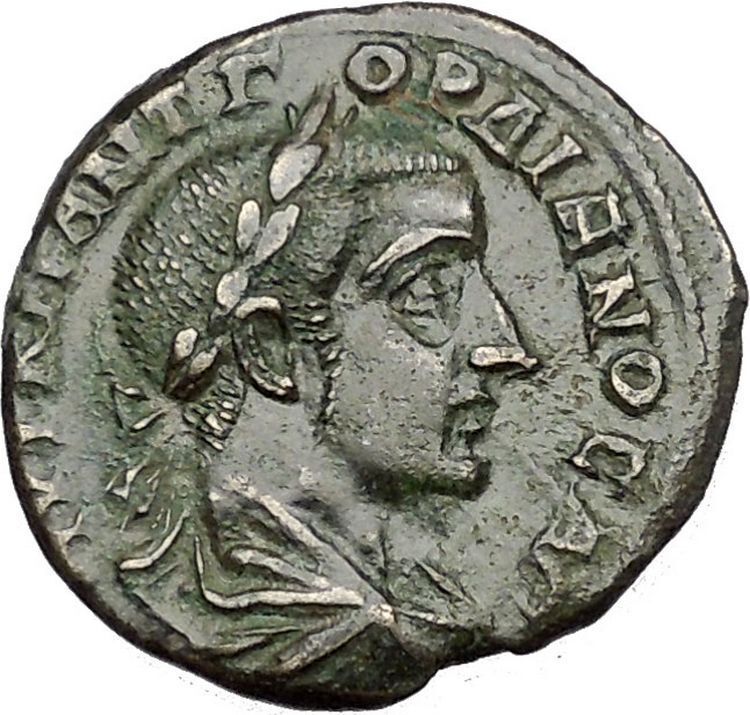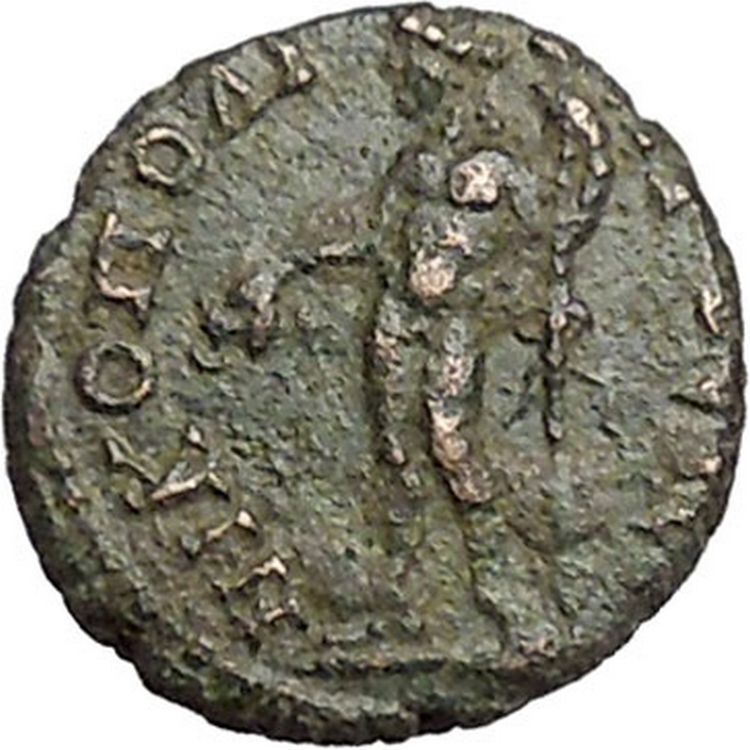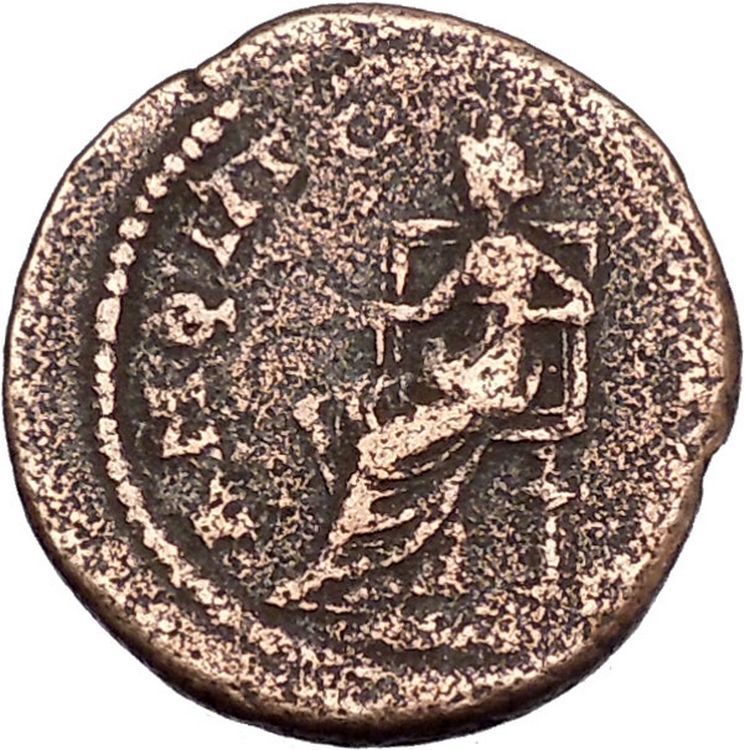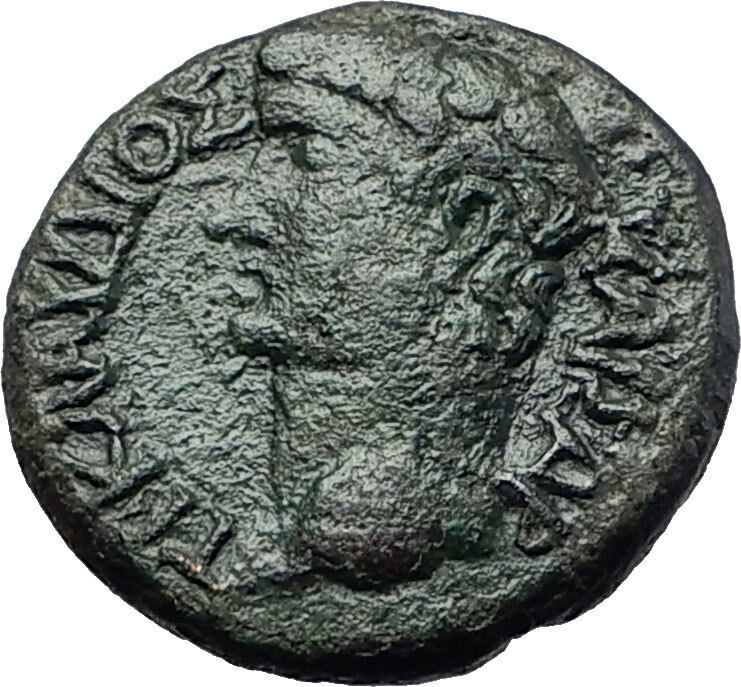|
Vespasian – Roman Emperor: 69-79 A.D. –
Silver Tetradrachm 22mm (13.41 grams) Antioch in Seleukis and Pieria mint, year 2, 69/70 A.D.
Reference: RPC II 1945; Wruck 79; McAlee 11
Certification: NGC Ancients Ch VF 4375823-281
AYTOKPAT KAIΣA OVEΣΠAΣIANOY, Laureate head of Vespasian right.
ETOYΣ B IEPOY, Eagle standing left on club; in left field, palm branch.
You are bidding on the exact item pictured, provided with a Certificate of Authenticity and Lifetime Guarantee of Authenticity.

Vespasian – Roman Emperor: 69-79 A.D.
69-71 A.D. – Sole Reign (with Titus and Domitian as Caesars)
71-79 A.D. – Sole Reign (with Titus as Imperator and Domitian as Caesar)
| Husband of Domitilla the Elder | Father of Titus, Domitian and Domitilla the Younger | Father-in-law of Domitia | Grandfather of Julia Titi | Great-grandfather of Vespasian Junior |
Titus Flavius Vespasianus, known in English as Vespasian (November 17 9AD – June 23 79AD), was a Roman Emperor who reigned from 69 AD until his death in 79 AD. Vespasian was the founder of the short-lived Flavian dynasty, which ruled the Roman Empire between 69 AD and 96 AD He was succeeded by his sons Titus (79–81) and Domitian (81–96).
Vespasian descended from a family of equestrians which rose into the senatorial rank under the emperors of the Julio-Claudian dynasty. Although he attained the standard succession of public offices, holding the consulship in 51, Vespasian became more reputed as a successful military commander, partaking in the Roman invasion of Britain in 43, and subjugating the Judaea province during the Jewish rebellion of 66. While Vespasian was preparing to besiege the city of Jerusalem during the latter campaign, emperor Nero committed suicide, plunging the Roman Empire into a year of civil war known as the Year of the Four Emperors. After Galba and Otho perished in quick succession, Vitellius became emperor in mid 69. In response, the armies in Egypt and Judaea themselves declared Vespasian emperor on July 1. In his bid for imperial power, Vespasian joined forces with Gaius Licinius Mucianus, the governor of Syria, who led the Flavian forces against Vitellius, while Vespasian himself gained control over Egypt. On December 20, Vitellius was defeated, and the following day, Vespasian was declared emperor by the Roman Senate.
Little factual information survives about Vespasian’s government during the ten years he was emperor. His reign is best known for financial reforms following the demise of the Julio-Claudian dynasty, the successful campaign against Judaea, and several ambitious construction projects such as the Colosseum. Upon his death on June 23, 79, he was succeeded by his eldest son Titus.
After the death of Nero in 68, Rome saw a succession of short-lived emperors and a year of civil wars. Galba was murdered by Otho, who was defeated by Vitellius. Otho’s supporters, looking for another candidate to support, settled on Vespasian.
According to Suetonius, a prophecy ubiquitous in the Eastern provinces claimed that from Judaea would come the future rulers of the world. Vespasian eventually believed that this prophecy applied to him, and found a number of omens, oracles, and portents that reinforced this belief .
He also found encouragement in Mucianus, the governor of Syria; and, although Vespasian was a strict disciplinarian and reformer of abuses, Vespasian’s soldiers were thoroughly devoted to him. All eyes in the East were now upon him. Mucianus and the Syrian legions were eager to support him. While he was at Caesarea, he was proclaimed emperor (July 1, 69), first by the army in Egypt under Tiberius Julius Alexander, and then by his troops in Judaea (July 11 according to Suetonius, July 3 according to Tacitus).
Nevertheless, Vitellius, the occupant of the throne, had Rome’s best troops on his side — the veteran legions of Gaul and the Rhineland. But the feeling in Vespasian’s favour quickly gathered strength, and the armies of Moesia, Pannonia, and Illyricum soon declared for him, and made him the de facto master of half of the Roman world.
While Vespasian himself was in Egypt securing its grain supply, his troops entered Italy from the northeast under the leadership of M. Antonius Primus. They defeated Vitellius’s army (which had awaited him in Mevania) at Bedriacum (or Betriacum), sacked Cremona and advanced on Rome. They entered Rome after furious fighting. In the resulting confusion, the Capitol was destroyed by fire and Vespasian’s brother Sabinus was killed by a mob.
On receiving the tidings of his rival’s defeat and death at Alexandria, the new emperor at once forwarded supplies of urgently needed grain to Rome, along with an edict or a declaration of policy, in which he gave assurance of an entire reversal of the laws of Nero, especially those relating to treason. While in Egypt he visited the Temple of Serapis, where reportedly he experienced a vision. Later he was confronted by two labourers who were convinced that he possessed a divine power that could work miracles.
Vespasian as emperor
Vespasian was declared emperor by the Senate while he was in Egypt in December of 69 (the Egyptians had declared him emperor in June of 69). In the short-term, administration of the empire was given to Mucianus who was aided by Vespasian’s son, Domitian. Mucianus started off Vespasian’s rule with tax reform that was to restore the empire’s finances. After Vespasian arrived in Rome in mid-70, Mucianus continued to press Vespasian to collect as many taxes as possible.
Vespasian and Mucianus renewed old taxes and instituted new ones, increased the tribute of the provinces, and kept a watchful eye upon the treasury officials. The Latin proverb “Pecunia non olet” (“Money does not smell”) may have been created when he had introduced a urine tax on public toilets. By his own example of simplicity of life — he caused something of a scandal when it was made known he took his own boots off — he initiated a marked improvement in the general tone of society in many respects.
In early 70, Vespasian was still in Egypt, the source of Rome’s grain supply, and had not yet left for Rome. According to Tacitus, his trip was delayed due to bad weather. Modern historians theorize that Vespasian had been and was continuing to consolidate support from the Egyptians before departing. Stories of a divine Vespasian healing people circulated in Egypt. During this period, protests erupted in Alexandria over his new tax policies and grain shipments were held up. Vespasian eventually restored order and grain shipments to Rome resumed.
In addition to the uprising in Egypt, unrest and civil war continued in the rest of the empire in 70. In Judea, rebellion had continued from 66. Vespasian’s son, Titus, finally subdued the rebellion with the capture of Jerusalem and destruction of the Jewish Temple in 70. According to Eusebius, Vespasian then ordered all descendants of the royal line of David to be hunted down, causing the Jews to be persecuted from province to province. Several modern historians have suggested that Vespasian, already having been told by Josephus that he was prophesied to become emperor whilst in Judaea, was probably reacting to other widely-known Messianic prophecies circulating at the time, to suppress any rival claimants arising from that dynasty.
In January of the same year, an uprising occurred in Gaul and Germany, known as the second Batavian Rebellion. This rebellion was headed by Gaius Julius Civilis and Julius Sabinus. Sabinus, claiming he was descended from Julius Caesar, declared himself emperor of Gaul. The rebellion defeated and absorbed two Roman legions before it was suppressed by Vespasian’s brother-in-law, Quintus Petillius Cerialis, by the end of 70.
Arrival in Rome and gathering support
In mid-70, Vespasian first came to Rome. Vespasian immediately embarked on a series of efforts to stay in power and prevent future revolts. He offered gifts to many in the military and much of the public. Soldiers loyal to Vitellius were dismissed or punished. He also restructured the Senatorial and Equestrian orders, removing his enemies and adding his allies. Regional autonomy of Greek provinces was repealed. Additionally, he made significant attempts to control public perception of his rule.
Propaganda campaign
Many modern historians note the increased amount of propaganda that appeared during Vespasian’s reign. Stories of a supernatural emperor who was destined to rule circulated in the empire. Nearly one-third of all coins minted in Rome under Vespasian celebrated military victory or peace. The word vindex was removed from coins so as not to remind the public of rebellious Vindex. Construction projects bore inscriptions praising Vespasian and condemning previous emperors. A temple of peace was constructed in the forum as well. Vespasian approved histories written under his reign, ensuring biases against him were removed.
Vespasian also gave financial rewards to ancient writers. The ancient historians who lived through the period such as Tacitus, Suetonius, Josephus and Pliny the Elder speak suspiciously well of Vespasian while condemning the emperors who came before him. Tacitus admits that his status was elevated by Vespasian, Josephus identifies Vespasian as a patron and savior, and Pliny dedicated his Natural Histories to Vespasian, Titus.
Those who spoke against Vespasian were punished. A number of stoic philosophers were accused of corrupting students with inappropriate teachings and were expelled from Rome. Helvidius Priscus, a pro-republic philosopher, was executed for his teachings.
Construction and conspiracies
Between 71 and 79, much of Vespasian’s reign is a mystery. Historians report that Vespasian ordered the construction of several buildings in Rome. Additionally, he survived several conspiracies against him.
Vespasian helped rebuild Rome after the civil war. He added the temple of Peace and the temple to the Deified Claudius. In 75, he erected a colossal statue of Apollo, begun under Nero, and he dedicated a stage of the theater of Marcellus. He also began construction of the Colosseum.
Suetonius claims that Vespasian was met with “constant conspiracies” against him. Only one conspiracy is known specifically, though. In 78 or 79, Eprius Marcellus and Aulus Caecina Alienus attempted to kill Vespasian. Why these men turned against Vespasian is not known.
Military pursuits and death
In 78, Agricola was sent to Britain, and both extended and consolidated the Roman dominion in that province, pushing his way into what is now Scotland. On June 23 of the following year, Vespasian was on his deathbed and expiring rapidly, he demanded that he be helped to stand as he believed “An emperor should die on his feet”. He died of an intestinal inflammation which led to excessive diarrhea. His purported great wit can be glimpsed from his last words; Væ, puto deus fio, “Damn. I am already becoming a god!”
|














